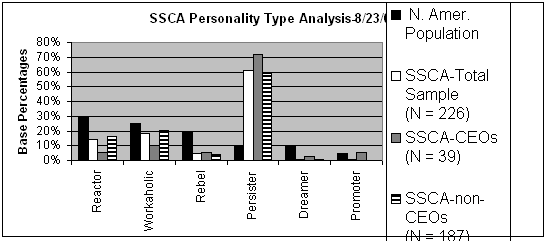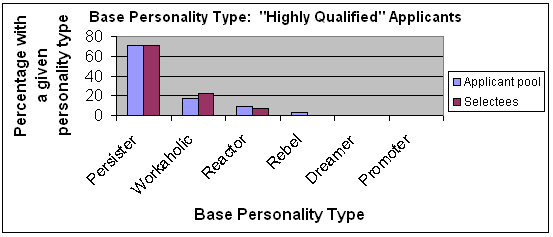By Scott Spencer
The process of selecting an astronaut is no easy task. The people who select the astronauts are choosing from the best of the best, physically and mentally. There are many factors that go into picking an astronaut besides the physical testing and background checks. One example of this is a little-known tool NASA uses to find out which astronauts will be the most mentally strong and capable under situations of intense stress and pressure. It is called the Process Communication Model, or PCM. Developed by Dr. Taibi Kahler in 1972, PCM breaks down each person into 6 different personality types. Each type has its strengths and weaknesses, but none are necessarily better or worse. However, the data shows that one personality type in particular has a much higher percentage in the astronaut core than in the general population. The persister personality type is far more likely to succeed in the astronaut selection process as well as actual space travel than any other personality type due to their underlying drive to be perfect and to help others reach perfection, which ultimately has the effect of making NASA the best organization it can be.
In the development of the Process Communication Model, Kahler started with a group of 1200 subjects, and was able to identify a series of subtle behaviors that are linked to miscommunication and distress that people impose on themselves and others.[1] He called these behaviors “drivers.” The primary drivers are: 1) be perfect, 2) please others, 3) be strong, 4) try hard, and 5) hurry up.[2] The next step was to correlate the drivers with seventy-eight personality variables. This allowed Kahler to identify the six primary personality types, but at first his findings were quite discouraging. He would later find the reason for this is that people go through “phase changes,” and do not always remain in their base personality type. When a person goes into a phase, they do most of their everyday activities in that phase, but always revert to their base at times of stress, danger, or extreme importance.
Although the process of forming the PCM model was very complicated and detailed, yet the end result is relatively simple and easy to understand. Every person has all six of the personality types in varying strengths. The model is often described as a condominium, in which a person’s base personality type is the ground floor (the easiest and most accessible). Their weakest and least accessible personality type would be the sixth floor. The following is a brief overview of the six different personality types in their simplest form. It is important to keep in mind that these descriptions do not show any influence of the other personality types that the person might possess.
A “rebel” is spontaneous and energetic. They think outside the box, and their enthusiasm, creativity, and playfulness often add to the morale of a team or group. They often take solace in a creative outlet such as music, and generally have a good sense of humor. However, they are often negative, stubborn, procrastinative, and blameful. Examples of rebels are James Dean, Scarlett O’Hara, and Janis Joplin. In terms of astronauts, Sally Ride is said to have been in a rebel phase. They constitute twenty percent of the North American population, though a rebel is very rare in the astronaut core.
A “reactor” is compassionate, sensitive, warm and nurturing. When put under pressure, however, they become over-reactive, dramatic, dependent, egocentric, and fail to think clearly. Examples of reactors are Mr. Rogers, Mary Tyler Moore, and Dr. “Bones” McCoy. Reactors comprise thirty percent of the population, and three quarters of them are female. Though reactors are only the third most common personality type in astronauts, they have proven to be one of the most effective.[3]
A “Thinker” (formerly known as a “Workaholic”) is responsible, logical, organized, and time oriented. However, in extreme situations, they become rigid, over-conscientious, humorless, ritualistic, and controlling. Examples of workaholics are Thomas Paine, De Cartes, and Mr. Spock. Workaholics make up about twenty-five percent of the U.S. general population, with three quarters being males. In terms of percentages, they make up approximately 22% of the astronaut core.
A “Promoter” is resourceful, adaptable, charming, and persuasive. They are the typical used car salesman. Unfortunately, they don’t learn from their mistakes, and when put under pressure are often impulsive, irresponsible, explosive, and vengeful. They make up only five percent of the population with sixty percent of them being men. This is a very dangerous personality type for an astronaut to have. Interestingly, Patricia Santy, a key player in the selection of astronauts, was in a promoter phase during her tenure at NASA.
“Imaginers” (formerly known as a “Dreamers”) are reflective, imaginative, directable, and calm. They are also very often shy, sensitive, introverted, non-competitive, and seclusive. They are frequently described as “loners.” Examples include most Trappist monks, Greta Garbo, and Gary Cooper’s movie characters. About ten percent of Americans are dreamers, sixty percent being female. This personality type is nonexistent at NASA.
“Persisters” are dedicated, observant, conscientious, and tenacious. Under extreme stress however, a Persister may become jealous, righteous, judgmental, opinionated, hypersensitive to negative feedback, and suspicious. Examples are Mother Teresa, Sherlock Holmes, Archie Bunker, and Martin Luther King. Persisters constitute about ten percent of the population, and three quarters of them are males. The persister is the most important personality type at NASA.
It is interesting to note that people of certain personality types are more likely to have certain roles in society than those of a different personality type. For example, it has been proven that a “persister” has a far greater chance of being a CEO or high-level employee of a company than all other types.[4] It is quite interesting that this same pattern has held true in the astronaut program. For example, in the 1984, ’85, ’87 selection cycle, 71% of those selected were base persisters.[5] Matched with workaholics, these two personality types make up 93% of the astronaut population. While this number is quite high (especially considering that combined they comprise only 35% of the North American population), there is a very good explanation for it. These two types use the be-perfect driver, which has been with them throughout their life. As a child, they were more likely to excel in school, get into a better college, and be more focused on achieving difficult and long-term goals. This data shows us that the prototypical astronaut is a perfectionist. Furthermore, because the majority of astronauts are persisters, most will also be highly critical of his or her environment and its contents. This person generally lacks a friendly, warm, open demeanor. Rather, they are goal oriented, logical, observant, and driven to achieve. If this person believes in something strongly, they will do everything in their power to impose this view on their colleagues. It is important to note that this person communicates much better with other thinkers. For example, a persister or workaholic often finds it difficult to understand how a reactor can be so sensitive and make so many mistakes. However, they greatly benefit from a reactor’s praises. If there are two or more persisters with differing points of view, it will also be quite difficult for them to get along. They will spend their time trying to impose their views on the other(s), who are already strongly biased and opinionated.
For this reason, Dr. McGuire suggests that in the future, as we approach the age of the space station, it will be increasingly necessary to consider personality types with the please others driver (the reactor has the strongest please others driver). This will keep the moral of the crew higher during extended flights and allow persisters and workaholics to be sufficiently and genuinely recognized for their strengths.
Dr. Kahler sees this as a “great opportunity for women to break through the glass-ceiling holding them back in space travel.”[6] He cites the fact that two-thirds of all reactors are women as a key to increasing the number of women in NASA. He warns, however, that while a reactor base is very important, the woman (or man) will also have to demonstrate many other characteristics often seen in persisters and workaholics to be effective on the job.
McGuire claims that not only will reactors become increasingly valuable in the future, but also that the very best Mission Commanders in the past (except for one) have all had very strong reactor parts. These people have been able to get the best performance out of their crew. He gives the example of Frederick Hauck, the commander on NASA’s return to space after the challenger accident. He claims that NASA chose their very best crew for this trip, and Hauck was able to draw upon the strengths of all his crewmembers in an efficient and likeable manner. He was a man with a reactor base, in a persister phase, with the next strongest type being workaholic.[7]
Perhaps the most famous astronaut is John Glenn. His personality profile is quite typical of an astronaut, but when McGuire speaks of Glenn, his enthusiasm, respect, and excitement are far from ordinary. Glenn is a persister base, in a workaholic phase, with a lot of reactor. His strong beliefs (stemming from the persister) were quite evident early on in the program. McGuire detailed how Glenn would try to persuade the other astronauts not to give in to all the attention they had been receiving (especially all the girls that were throwing themselves at the astronauts). He realized that they were role models for America, and he was committed to keeping their image clean. Simply put, McGuire stated, “John Glenn was the best of the first seven astronauts.” This goes for on the ground and in the air. When the red lights came on during his scary flight in space, McGuire recalls hearing how calm and collected Glenn sounded over the radio in troubleshooting the problem. He described him as “Mr. Cool.” As much as Glenn was all business in the air and in front of the press, he was not afraid to let his reactor side come out either. McGuire remembers a time when something sad had happened to a friend, and Glenn cried openly. Furthermore, he was a great father and husband. John Glenn truly was a model astronaut, and an ideal example of a persister trying to impose his views on those around him, while still working hard to achieve personal success.
Al Shepard on the other hand had a somewhat more volatile personality package. He was a persister in a promoter phase, with workaholic next in line. McGuire stated, “He had the ability to create a great deal of discomfort for the rest of us.” It is easy to imagine how Shepard’s promoter parts could clash with Glenn’s strong persister values.
McGuire also emphasizes the importance of phasing. A person who has gone through many different phases is able to identify with people of other types much easier and more effectively. For this, he gives the example of Sharon McAuliffe from the Teacher in Space Program. He says that she had most likely phased four times, and for that reason, was able to associate and communicate easily with almost anybody. She was a base reactor.
Just as women are more likely to choose other women as their close friends, people of a given personality type are more likely to value the beliefs of others from that type. With regard to NASA, it would make sense that the personality types of the selectors would be reflected in the selectees.[8] To get to a high enough position in NASA to have an influence on the selection of astronauts, one would most likely need to be very logical, driven, hardworking, observant and dedicated (the traits of persisters and workaholics). As these highly opinionated people see it, there is little room in the NASA organization for playfulness (rebel), shyness (dreamer), persuasiveness / deceptiveness (promoter), or even the sensitivity shown by reactors. Therefore, the persisters and workaholics at NASA usually choose astronauts that reflect their own personal values. Both McGuire and Kahler verified the intensity and stressful atmosphere at NASA, caused by persisters and workaholics.
Many people have questioned why NASA has been an organization predominantly run by men, with almost all male astronauts. The answer may very simply lie in the statistics of personality types. Persisters and workaholics make up 93% of the astronaut core. A male is much more likely to be one of these two personality types than a female is. Therefore, a male is automatically more likely to be selected. Understandably, most of the females that are chosen display many of the characteristics more common of a male – they show little emotion and are driven and goal-oriented.
However, the tides are changing. In the new millennium, NASA will likely be moving away from predominantly persister astronauts. In a paper written by Terry McGuire to NASA, it was suggested that for the future, NASA have two pools of astronauts: one for the space station, and another for the space shuttle. He recommends that the space station astronauts will need to have a reactor base or have at least phased a few times. This will allow them to live in close quarters for long periods of time comfortably.
This does not diminish the fact for almost half a century, NASA has been dominated by persisters. Since its inception in 1958, NASA has attempted to recruit astronauts with the whole package – a very strong body, and an incredibly sound mind. Time after time, NASA has felt that the people with the best minds for the job tended to be persisters. The Process Communication Model has been an invaluable tool to NASA, for it has allowed them to pinpoint the people that have the characteristics they are looking for – the persisters. PCM is just one of the many factors that has helped to build NASA into the productive, strong, and successful organization that it is today.
Submitted for partial completion of credit requirements
CORNELL UNIVERSITY
December, 2000
Scott Spencer
Works Cited
McGuire, Terence F., M.D., Astronauts; Reflections on Current Selection Methodology,
Astronaut Personality, and the Space Station.
Kahler, Taibi, Ph.D., “Drivers—The Key to the Process Script”. Transactional Analysis
Journal, 5:3, July 1975.
Bradford F. Spencer, Ph.D and Christopher Demaci, M.A., Spencer, Shenk, Capers &
Associates, Inc. Personality Type Analysis Report.
Personal Interview, Terence F. McGuire, M.D., Consultant in psychiatry to NASA,
Saturday, November 25, 2000.
Personal Interview, Taibi Kahler, Ph.D., Friday, November 24, 2000.
Personal Interview, Bradford F. Spencer, Ph.D., Thursday, November 23, 2000.
[1] McGuire, Terence F., M.D., Astronauts; Reflections on Current Selection Methodology, Astronaut Personality, and the Space Station. P. 6.
[2] Kahler, Taibi, Ph.D., “Drivers—The Key to the Process Script”. Transactional Analysis Journal, 5:3, July 1975.
[3] Personal Interview, Terence F. McGuire, M.D. Saturday November 25, 2000.
[4] Bradford F. Spencer, Ph.D and Christopher Demaci, Spencer, Shenk, Capers & Associates, Inc. Personality Type Analysis Report. P. 12.

[5] Astronauts; Reflections on Current Selection Methodology, Astronaut Personality, and the Space Station by Terence F. McGuire, M.D., p. 24, fig. 8

[6] Personal interview, Dr. Taibi Kahler, Friday, November 24, 2000.
[7] Personal interview, Dr. Terence E. McGuire, Saturday, November 25, 2000.
[8] McGuire, personal interview.
